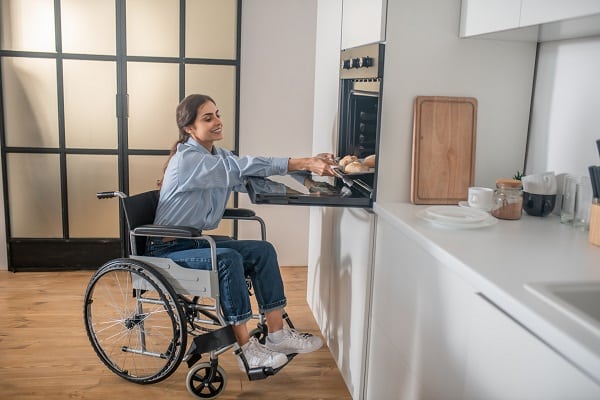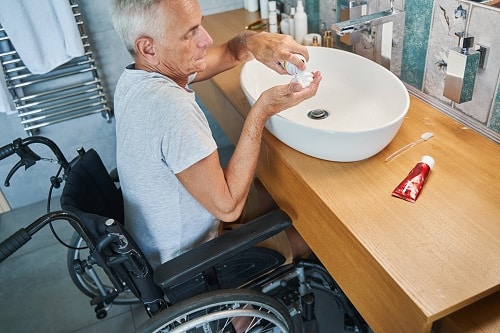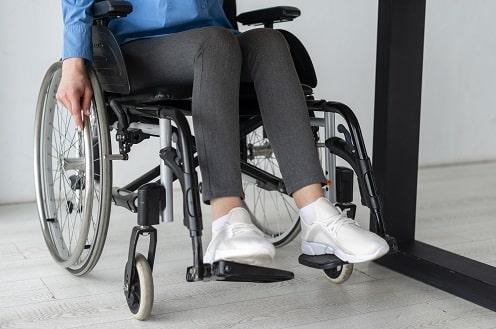Is hope on the horizon for spina bifida, a birth defect that happens when the spine and spinal cord don’t form properly? Can spina bifida be cured any time in the near future? What we do know is there are advanced treatments available for those living with this condition, and recent strides in medical science offer hope that one day spina bifida in Australia and beyond could be cured.
Keep reading. This article looks at what spina bifida is, as well as technology and advancements around this condition.
In this article

What is spina bifida?
Spina bifida is a congenital condition (i.e., it exists at or before birth) that affects the spinal cord.
This neural tube defect occurs when the spine and spinal cord don’t form properly during early pregnancy, which can lead to a range of challenges and health issues for individuals affected by it. Some people with spina bifida have mild symptoms, while others have severe physical disabilities.
Around 1 in every 2,000 babies are born with spina bifida in Australia. Globally, the numbers are slightly higher, with approximately 1 in every 1,000 newborns affected.
What causes it?
The exact cause of spina bifida is still a subject of ongoing research, but a combination of genetic and environmental factors seems to play a crucial role. Some studies suggest that insufficient intake of folic acid, a B vitamin, during early pregnancy may increase the risk of a baby developing spina bifida.
What are the symptoms of spina bifida?
The symptoms of spina bifida can vary widely depending on the type and severity of the condition. In more severe cases like myelomeningocele (explained further down), individuals may experience paralysis, bladder and bowel control issues, and even learning disabilities. Milder forms may only present with subtle physical abnormalities, making them harder to detect.
The spinal cord is a bundle of nerves that carries messages between the brain and the rest of the body. When the spinal cord is damaged, it can result in:
- Weakness or paralysis in the legs
- Bladder and bowel control problems
- Loss of feeling in the legs and feet
- Learning disabilities
- Intellectual disabilities
Types of spina bifida in Australia
Spina bifida comes in different forms, with the severity of the condition determining the type:
Spina bifida occulta
This is the mildest type of spina bifida. The opening in the spine is small and there are no visible symptoms. Most people with this type don’t even know they have it.
Meningocele
This type is characterised by a fluid-filled sac that protrudes from the opening in the spine. The sac contains the meninges, which are the membranes that protect the spinal cord. People with meningocele may have some nerve damage, but it’s usually mild.
Myelomeningocele
This is the most common type of spina bifida in Australia and globally. In myelomeningocele, a sac of fluid protrudes from the opening in the spine and contains part of the spinal cord and nerves. This type of spina bifida can cause moderate to severe disabilities, such as problems walking, bladder and bowel control, and feeling in the legs and feet.
Lipomeningocele
This is a rare type of spina bifida characterised by a fatty mass that protrudes from the opening in the spine. Lipomeningocele can cause nerve damage and other problems, but the severity varies.

Can spina bifida be cured?
Historically, the treatment for spina bifida has focused on managing its symptoms and preventing complications. Currently, the answer to can spina bifida be cured is no, however there are treatments that can minimise the effects.
These approaches include:
Gene therapy
Gene therapy is a new type of treatment that uses genes to correct genetic defects. While the use of it for spina bifida is still in the early stages of development, it has the potential to improve the lives of people with this condition.
One way it can do that is to deliver a healthy gene to the spinal cord. This gene can help to repair the damaged nerves and improve nerve function. It can also deliver a gene that can prevent the spinal cord from deteriorating further.
Gene therapy for spina bifida is still in the early stages of development, but it has the potential to be a life-changing treatment for people with this condition.
While it’s not yet available to the public, there are a number of clinical trials underway to test the safety and efficacy of this treatment and explore this approach as a potential way for spina bifida to be cured.
Foetal surgery
One of the most promising breakthroughs in treating spina bifida in Australia involves foetal surgery. This procedure, performed during pregnancy, aims to repair the spinal defect while the baby is still in the womb. By closing the gap in the spine early on, doctors hope to prevent further damage to the exposed spinal cord and nerves.
Watch this video for more insights.
Stem cell therapy
Stem cells are special cells that can develop into any type of cell in the body and stem cell therapy is a new type of treatment that uses them to repair damaged tissues and organs.
It too is being studied as a potential way for spina bifida to be cured, but at the very least improve nerve function and reduce the symptoms of spina bifida.
There are two main ways that stem cell therapy could be used:
- Prenatal stem cell therapy – where stem cells are injected into the foetus’s spinal cord before birth. This could help to prevent the spinal cord from being damaged in the first place.
- Postnatal stem cell therapy – where stem cells are injected into the spinal cord of a baby or child after birth in order to repair damage that’s already been done.
Stem cell therapy for spina bifida in Australia and globally is still in the early stages of development. However, there have been some promising results in animal studies. For example, one study showed that stem cell therapy was able to improve the ability of lambs with spina bifida to walk.
There are a number of clinical trials underway to test the safety and efficacy of stem cell therapy for spina bifida. One of them is The CuRe Clinical Trial at UC Davis, which is testing the use of stem cell patches to repair the spinal cord of foetuses with spina bifida.
Brain chips
Brain chips are tiny devices that can be implanted in the brain. They work by recording and stimulating the activity of brain cells. They’re still in the early stages of development, but have the potential to be used to treat a variety of neurological conditions, including spina bifida in Australia and globally.
Brain chips could be implanted in the spinal cord to record and stimulate the signals that control movement, which could allow people with paralysis to control their legs and walk again.
They could also help people with bladder and bowel control problems. An implant in the spinal cord could send a message to the brain chip to control the muscles that manage bladder and bowel function.
The NeuroBridge Trial is a clinical trial that’s testing the use of a brain-computer interface to help people with spinal cord injuries to walk again. The trial is still ongoing, but early results have shown it’s been able to help people regain some movement in their legs.
Theoretically, a brain chip like Elon Musk’s Neuralink would be able to help in a similar way. Check out our piece on Musk’s vison for cyborg limbs for more on this.
Mobility assistance for those with spina bifida
Advancements in prosthetics and assistive devices are providing individuals with spina bifida in Australia with greater mobility and independence. These include:
- Ankle-foot orthoses are braces that support the ankle and foot. They can help people with spina bifida to walk more easily and prevent deformities.
- Knee-ankle-foot orthoses support the knee, ankle, and foot. They help with walking and prevent deformities, especially if the person has weakness in the muscles above the knee.
- Reciprocal gait orthoses are braces that help to coordinate the movement of the legs when walking. They can help people with spina bifida to walk more easily and efficiently.
- Electric wheelchairs and stand-up wheelchairs can give people with spina bifida the freedom to move around without having to rely on others for assistance.
Exoskeletons
There are also cutting-edge technologies like exoskeletons that are revolutionising the way individuals with spina bifida in Australia and worldwide can navigate the world around them.
Exoskeletons are robotic devices that can be worn to support the body and help with movement. They’re still under development, but they have the potential to help people with spina bifida to walk and perform other activities that they would otherwise not be able to do.
One example is the EksoNR – a full-body exoskeleton that can help people with paralysis to stand, walk, and climb stairs. Another is the ReWalk exoskeleton, a lower-body exoskeleton that can help people with paralysis to walk.
Robotics
Nerve-controlled robotic limbs are prosthetic limbs that are controlled by the user’s own nerve signals. This means that people with spina bifida can use their own thoughts to control their prosthetic limbs.
Some examples of nerve-controlled robotic limbs is the DEKA Luke arm and Bionic Hand. This is where prosthetic arms are controlled by the user’s own nerve signals.
Be sure to read our piece on the latest innovations in assistive technology for more on these and other amazing breakthroughs.
The below advances may also interest those living with spina bifida in Australia:
- Did You Know About These Wheelchair Advancements?
- The Changing Face of Disability Converted Vehicles
- Treatment Advances for Motor Neurone Disease: What You Need to Know
- Research Advances You Should Know About for Brain Awareness Week 2023
- The Latest Smartphone Accessibility Features You Should Know
Insurance for your independence
While the answer to can spina bifida be cured is currently a no, science is making headways in leap and bounds.
In the meantime, wheelchairs, mobility scooters and converted vehicles are still the best way to move around when you live with mobility issues. With these devices so integral to our independence, it can be a huge stress if they’re damaged or broken. As a disability insurance specialist, Blue Badge Insurance offers discounts to those who need it most.
Find out about getting up to 25% off disability car insurance with your disability parking permit. Read up on our wheelchair insurance and mobility scooter insurance too. Your plan helps pay for bills such as repairs or even replacement. Click below to find out more by getting a quote.








